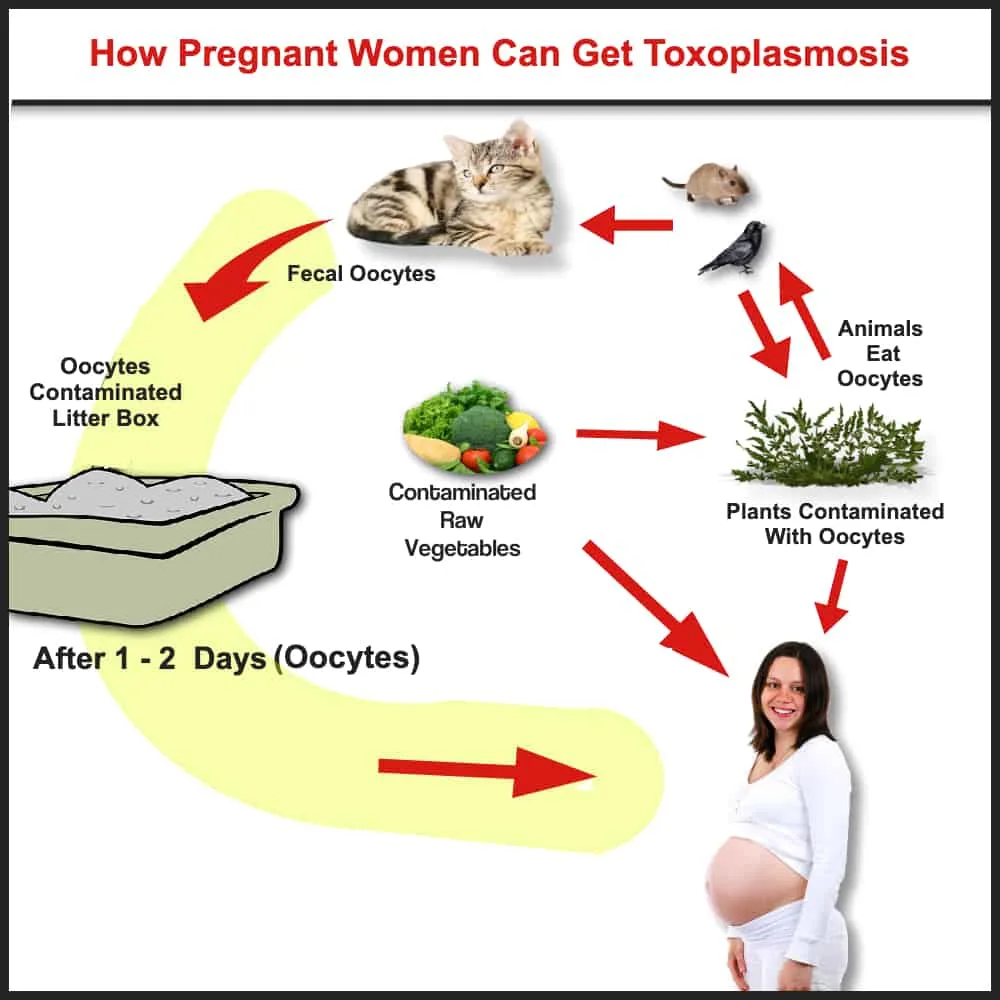Updated August 3, 2022

Photo Credit: Family Cat Life
One of the most frequent questions we would get in our OB/GYN office from newly pregnant women is “Should I get rid of my cat?” A completely understandable question given some of the myths and tales surrounding cats and pregnancy. We want to help you separate the myths from the facts on the question “Can pregnant women be around cats?”
American households own over 85 million cats. In fact, Americans own more cats than dogs! Many households own more than one cat. (Source)
So it isn’t surprising that many newly pregnant women ask their OB/GYN or midwife questions about their cats and pregnancy risks.
This post may contain affiliate links. If you make a purchase, we may be compensated. You can read our full disclosure at the bottom of the post.
Can pregnant women be around cats?
Yes. pregnant women can be around cats. Pregnant women need to be careful cleaning their cat’s litter box and need to avoid coming into contact with cat feces. That is because cat feces can carry a parasite called Toxoplasmosis which can harm your growing fetus. You should have your partner or someone else scoop, clean, and change the cat litter box while you are pregnant.

So now you know that pregnant women can be around cats. You do not have to rehome your cat, you just need to be more cautious in the care of your cat during pregnancy.
You do not need to give up your cat. That is a myth that has caused more than one pregnant woman anxiety and stress!
Now that your beloved cat is staying, let’s talk more about the best ways to keep you safe from Toxoplasmosis infection during pregnancy.
[content-egg module=Amazon template=grid next=4 hide=price]
Let’s talk about what toxoplasmosis is:
- How you could get it (hint: not just from your cat).
- What can happen to your baby if you get it during pregnancy?
- How to make sure you don’t get toxoplasmosis.

Photo Credit: Family Cat Life
What is Toxoplasmosis?
If you are pregnant and have a cat, you want to learn about Toxoplasmosis. Most importantly, you will want to learn how to prevent exposure to this parasite while you are pregnant.
Toxoplasma Gondii is the organism that causes Toxoplasmosis.
This organism is a unicellular (one-celled) protozoan that can infect all warm-blooded animals including humans through:
- A contaminated litter box
- Raw vegetables and fruits
- Meat containing the cyst form of the organism (meat must be well-cooked to kill the parasite)
- Garden soil, sand, and dirt that has been contaminated with cat feces.
[wps_youtube url=”https://youtu.be/T5mrfsBCT50″ width=”600″ height=”400″ responsive=”yes” autoplay=”no”]
How common is Toxoplasmosis?
How common toxoplasmosis is in the general population is a statistic that even Doug as a Doctor and myself as a Registered Nurse found surprising. It is higher than we expected in the US but much lower than in European and South American countries.
The reason it is higher in other countries is not because of cats or contact with cat feces, it is higher because they consume more raw and undercooked meat than we do in the US.
Relatively speaking, Toxoplasmosis is a common infection in the general population. It is estimated that 25% of the population in the US have been exposed to Toxoplasma gondii.
There are about 225,000 cases of Toxoplasmosis that present with symptoms each year in the US. (Source)
As high as 40% of cats have been exposed, but 1% or less are shedding infectious eggs or oocytes. So the risk of getting toxoplasmosis from your own cat is low.
That is why it isn’t necessary to rehome your cat when you are pregnant. Nor do you need to stay away from your cat if you are pregnant.

How is toxoplasmosis transmitted?
Parasites, unlike other organisms, have a life cycle that requires a “host” to survive. Toxoplasmosis Gondii also has an intermediate host (mouse or other warm-blooded animals) which can be the mode of transmission to your cat.
What is concerning for pregnant women is that the domestic house cat is the definitive host for the life cycle of Toxoplasma gondii.
This makes the house cat a vector for transmission of the parasite to household members who are in contact with the cat’s feces when changing the litter box. That’s why the question “Can pregnant women be around cats?” is asked so often.
In your cat’s feces, the organism is present in the egg form (oocyte). The life-cycle of this parasite (granted not pleasant to talk about) is called the fecal-oral life-cycle.

Photo Credit: Maternity Comfort Solutions.
Most of the articles we read on this subject suggest that the odds of your indoor cat getting toxoplasmosis is very slim to non-existent. We have owned indoor and outdoor cats.
Maybe it is our love of old houses, but even our indoor cats would catch field mice that would come in looking for warmth or food.
Even living in a new home in Arizona, our indoor cats would catch the occasional lizard or mouse that would somehow get in.
We feel that while indoor cats may be less likely to have toxoplasmosis than outdoor cats, your handling of their litter box during pregnancy should be the same.

Photo Credit: Family Cat Life
What can happen if a pregnant woman becomes infected with Toxoplasmosis?
If you become infected with Toxoplasmosis during your pregnancy, you can transmit the parasite to your baby. Toxoplasmosis can cause birth defects and fetal death.
If a baby is infected with Toxoplasmosis during pregnancy, it is called “congenital toxoplasmosis”.
The effects on the baby depend on the time the infection occurred during pregnancy.
- Most often newborn babies infected in utero do not show signs of Toxoplasmosis infection at the time of delivery.
- Toxoplasmosis has been associated with miscarriages and stillborns.
- The infection can cause fetal brain or other organ damage (especially eyes) though symptoms may not show up until later in life. (Source)
Toxoplasmosis infection is common in the general population. Most individuals are not aware they had the infection since the symptoms are mild, flu-like symptoms.
Not all women infected during pregnancy will pass the infection to their baby. It is estimated that maternal infection is passed to the baby 3-4 out of 10 times.

Photo Credit: Family Cat Life
Related: 10 First Trimester Survival Tips You’ll Be Glad You Know
How to prevent toxoplasmosis infection during pregnancy?
There are safety precautions you should take to avoid being exposed to Toxoplasma gondii during pregnancy:
- Be sure the cat box is cleaned daily. It takes 1-3 days for the parasite shed by your cat in their feces to become infectious.
- Avoid changing the litter box. Have your partner or someone else empty and clean the litter box.
- If you have to clean the litter box, wear gloves (disposable) and a mask. Wash your hands with soap and water when you are done. Scrub your hands for at least 20 seconds before you rinse off the soap and dry your hands.
- Do not feed your cat raw meat. Feed your cat a good commercial brand cat food.
- Don’t get a new cat or kitten while you are pregnant. Do not volunteer in a cat shelter or cat rescue during pregnancy,
- Don’t pet cute kittens for sale or adoption at pet stores.
- Do not feed or touch feral cats in your neighborhood. (Some neighborhoods have colonies of feral cats that have been spayed/neutered and released back into the area.)
- If you have other children and have an outdoor sandbox, keep the box covered when not in use and make sure your children wash their hands with soap and water when they come inside.
- If you have a garden, make sure you wear gloves if you’ll be digging in it. Toxoplasma gondii can be found in soil and dirt contaminated with cat feces. Outdoor cats and feral cats will use gardens, sandboxes, soil as a litter box.
- Make sure the water you drink is from a clean source. It is possible to become infected from water contaminated with cat feces.
- Cook all of your meat to the proper temperature, do not eat undercooked meat. Wash all fruits and vegetables before consuming them.

Photo Credit: Maternity Comfort Solutions
How do you kill Toxoplasmosis?
It is difficult to kill the Toxoplasmosis parasite. Using steam, Ultraviolet-C or an industrial disinfectant are often recommended.
It can also be killed by washing litter boxes with boiling water to clean them. The organism is resistant to common household disinfectants.
What cat litter box is best to use during pregnancy?
Your choice of litter box goes a long way in helping you stay toxoplasmosis negative during pregnancy.
We currently use top entry cat litter boxes for our two cats. The beauty of top entry litter boxes is that all of the litter and cat feces is fully contained in the box.
Front entry litter boxes can be messy if you have cats that like to throw around their litter when they dig in the box.
It is going to be more dangerous to a pregnant woman to have dirty and possibly contaminated cat litter all over the floor. The top entry boxes eliminate dirty cat litter from ending up on the floor.
That can lower your risk of coming into contact with Toxoplasma gondii if your cat is infected and is shedding oocytes.
[wps_alert type=”note”][wps_icon icon=”check” background=”#31b522″ color=”#ffffff” size=”20″ padding=”6″ radius=”0″]This is the cat box our readers love the most for keeping the cat litter contained in the box.[/wps_alert]
IRIS Top Entry Cat Litter Box with Cat Litter Scoop
You can read the reviews and check the current price on Amazon.
The Iris top entry cat boxes get great reviews, they are an Amazon choice product, and they come in a variety of colors to fit in with your taste and decor.
The cat boxes we use in our house are called Clever Cat Litter boxes. They are top entry litter boxes. We have used them for 9 years now. They completely contain the litter in the box, keep our dogs from eating the cat poop and are super easy to clean. You can check them out on Amazon.
Here is a picture of what they look like:
The Iris top entry litter box is more aesthetically pleasing to look at than the Clever Cat boxes. The Clever cat boxes are quite plain, but they get the job done. I find the clever cat boxes so easy to clean.
These would be our two best recommendations in standard litter boxes for your cats if you are pregnant.
Another great option is a self-cleaning litter box. In which case, there is no scooping, cleaning or changing litter for weeks. Which could be an option if you have someone come over and clean the box for you.
We would still stick with a top entry self-cleaning box if possible or a front entry self-cleaning box that was designed to keep the litter in the box. That is going to be the best way to make sure you are not coming in contact with contaminated litter on the floor around the box.
PetSafe ScoopFree Ultra Self-Cleaning Cat Litter Box
There are a few of the great options available in cat litter boxes that will help keep you safe from toxoplasmosis during your pregnancy. The best part, of course, is that yes, if you are pregnant you can be around your cats.
Your beloved feline family member gets to stay and you have one less thing to be anxious about during your pregnancy!
If you found this article helpful, please share it! It would mean so much to us. Thank you.






